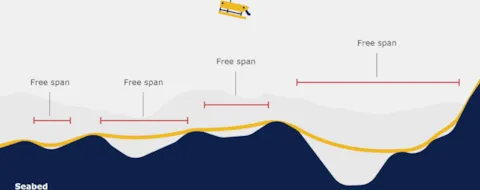Assessing pipelines in the digital age
With the vast amounts of both data processing power and storage opportunities, are there new possibilities to rethink how we assess the integrity of offshore pipelines?
Published: 29 May, 2018
Currently everyone is trying to digitalize something, and we often see that existing processes are being made more efficient. And by all means, let’s do that. However, we also need to have a look at the assumptions for why processes are what they are, and challenge if the assumptions are still valid. If we reframe our assumption, maybe we could find something much more valuable?
When computing power is free, why do we try to optimize the use of it? Some of our industry’s engineering services have typically been very computational heavy and we’ve naturally only wanted to use it when necessary. In the pipeline industry, we often talk about Level 1, Level 2 and Level 3 assessment. This is a way of filtering the negligible features before you get to a full level 3 assessment, which are the computer/engineering heavy element in the chain. We see this type of working process when evaluating internal and external corrosion, mechanical damage etc. This approach is adequate when the assumption that level 3 assessments are expensive are valid. Well, I believe in many cases this assumption is no longer valid. Today, some of these analyses can be automated and the cost is close to zero. Should we keep our old way of working?
In DNV we have challenged the process and tried something new in regards to free span management. The traditional approach has been a manual process; First, a simple screening criterion is established, then a screening of the reported spans against those criteria. If any spans don’t comply with the criteria, it is further evaluated and potentially taken forward for a more extensive engineering assessment. The level 3 assessments are often executed by a technical expert either internally or externally from the asset owner’s organization. And often included is some sort of sophisticated calculation tool, be that a finite element model, FatFree or similar.
Our new approach is that we’ve automated the level 3 assessments and can thereby do them for all free spans in one go. With the same effort that normally goes into one assessment. Once you take the manual elements out of the equation and add (almost) free computing power, you can easily skip the level 1 and level 2 assessment. In addition, we’ve made use of some of our fundamental research and the new approach gives even more detailed and accurate remaining fatigue life predictions than we normally associate with a level 3 assessment. There’s no need to assess whether the span is 50 or 80 meters long, the new way gives you the remaining fatigue life directly. And it does so point by point, rather than span by span.
Well, once you get all the inspection data to this level and attributed it to a digital twin (which is what we develop in the previous step), we can start taking advantage of another digital aspect. Namely that storage is also (almost) free these days. Once you have created the digital twin, you can keep it along with all of your data and it can easily be updated with the next survey data. When we keep track of the history development of the spans, we can much better predict the remaining life. Thereby removing unnecessary conservatism and avoid wasteful interventions. Hey! Those are expensive!
Case study:
This winter we applied the new tool to a 1.77 km, 4o inch pipeline in the North Sea, with 17 consecutive, interactive free spans of length 65m-83m driven by scouring. The automated calculations from the model saved both time consuming interaction calculations and demonstrated that present configuration was acceptable, accounting for interacting multi-spans. Previous work indicated fatigue life of 4 years, and plans were to cover the ~2km of pipe with a rock-berm.
After running the same date through the tool, the installation campaign was canceled and a cost savings of around 1 MUSD was achieved.
The case study exemplifies both the potential cost and efforts that can be saved with the new model. Moreover, the engineers applying the model can better utilize their time evaluating and assessing the free spans that actually are critical, rather than mundane, manual calculations. One thing is for sure – new digital tools and the new ways of working that comes with them, will unlock a huge potential in a whole range
If you’re interested in more details, please visit our landing page.
5/29/2018 8:00:00 AM
